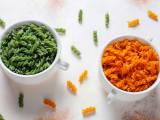Chlorophyll: why spring makes us want to eat green?

As soon as the first rays of sunshine appear, a reflex takes hold. We put away the winter soups, look at the young shoots, dream of crisp salads, fresh herbs and green peas. Like a visceral urge to eat "green".
But what if it wasn't just a matter of fashion or Instagrammable plates? What if this attraction to green had a biological, sensory and even emotional basis? Zoom in on chlorophyll, the plant molecule that seems to call to us as soon as spring resurfaces:
What exactly is chlorophyll?
Chlorophyll is the green pigment in plants. It's what gives them their brilliant color and captures light to trigger photosynthesis - the fabulous phenomenon that transforms sunlight into energy.
On our plates, it's found in :
- Fresh herbs (parsley, basil, coriander...)
- Leafy vegetables (spinach, chard, arugula, etc.)
- Cruciferous vegetables (broccoli, cabbage, watercress, etc.)
- Seaweed (spirulina, chlorella)
Beyond its pretty color, chlorophyll is far from anecdotal. It is often described as a veritable concentrate of benefits. Some studies even attribute antioxidant, anti-inflammatory and detoxifying properties to chlorophyll.
According to Santé Magazine, it helps oxygenate the blood, promotes cell regeneration and supports digestion.
Why do we crave green in spring?
1. A desire for lightness
After the rich, comforting dishes of winter, our bodies often crave a lighter touch. An instinctive need to "clean up", to get the machine moving again. It's what some call the "cabbage soup syndrome": the urge to eliminate, to return to a fresher, more plant-based diet.
Chlorophyll is well known for its beneficial effects on the liver and the elimination of toxins. It supports liver function and helps neutralize certain harmful substances, as shown by research carried out by the Linus Pauling Institute at the University of Oregon (Lin et al., 2001).
Nutritionist Dr Jérôme Bernard-Pellet reminds us that "the liver loves green vegetables". They are the natural allies of the detoxification metabolism.
2. Renewed vitality at the end of winter
As the days lengthen, energy slowly returns. Our diet plays a key role in this process. Foods rich in chlorophyll are packed with essential vitamins and minerals:
- Magnesium (anti-fatigue)
- Vitamin C (immunity)
- Vitamin K (bone health)
- Plant iron (blood oxygenation)
According to an article in Matelma, green vegetables also act as a "fertilizer" for our microbiota, strengthening our natural defenses.
3. A desire for nature... on the plate
In spring, we feel like opening our windows, walking barefoot in the grass and smelling the fresh air. This connection to the living world can also be found in our food choices. Green vegetables, fresh herbs, young shoots: they give us the impression of putting a little nature back into our daily lives.
As Noovo Moi points out, chlorophyll acts almost as a bridge between us and the plant world. It awakens our senses, reconnecting us to a gentler, more natural rhythm.
And visually, green remains the color of renewal. It soothes, gently stimulates and balances. In short, it feels good.
How can I make the most of chlorophyll?
A few simple gestures to put more green on your plate without complicating your life:
- Eat raw or lightly cooked: chlorophyll is fragile to heat. Think salads, gentle steams and green juices.
- Mix sources: baby greens, steamed broccoli, fresh herbs... Vary the pleasures!
- Think seaweed: spirulina, chlorella, or even nori and wakame for sprinkling.
- Use tops: often overlooked, radish, carrot or beet tops are full of flavor and very rich in chlorophyll.
- Try green smoothies: apple + spinach + lemon + ginger, a classic that wakes you up!
Santé Magazine's article reminds us, however, that chlorophyll is not a miracle cure. It works in synergy with a varied diet, rich in fiber, healthy fats and seasonal fruits and vegetables.
In a nutshell: eating green is a way of following your body's (and spring's) rhythm.
It's no coincidence that we're drawn to green when the warm weather returns. It's a color that wakes us up, comforts us and makes us feel good. And on the plate, this desire translates into fresher, lighter, livelier dishes.
Adding a little greenery to our meals is a simple, joyful way of welcoming spring. A small, everyday gesture, but a big step towards balance!
Source:
Lin, X. et al. (2001) - Chemopreventive effects of chlorophyllin. Carcinogenesis.
Santé Magazine - What are the health benefits of chlorophyll?
Matelma - Why are green vegetables so important to your health?
Noovo Moi - Why incorporate chlorophyll into your diet now?
Journal of the American Dietetic Association (2004) - Green leafy vegetables and chronic disease risk.
You may be interested in:
 Adèle Peyches
Adèle Peyches

Comments